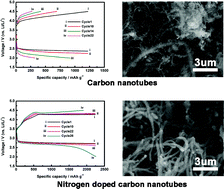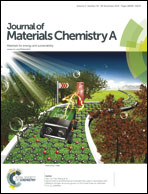Electrochemical performance of binder-free carbon nanotubes with different nitrogen amounts grown on the nickel foam as cathodes in Li–O2 batteries†
Abstract
Although studies have been done on nitrogen doped carbon materials as lithium–oxygen (Li–O2) battery cathodes, few of them focus on the binder-free electrode structure, although they have been proved to bring improved performance. To fill this gap this work not only studies the nitrogen doped binder-free carbon cathode but also determines the performance of these cathodes with different levels of nitrogen doping. To make binder-free electrodes, these CNTs and N-CNTs were synthesized on nickel foam by a floating catalyst chemical vapor deposition method. The study found that the electrochemical performance of binder-free N-CNT cathodes in Li–O2 batteries improves as the level of nitrogen doping increases. To further study the reason why the electrodes with higher nitrogen amounts deliver better electrochemical properties, the morphology of discharge products on the different nanotubes are detected by scanning electron microscopy (SEM). The scan shows that the distribution of discharge products on the surface of CNTs become more and more uniform as the level of nitrogen doping increases and the discharge capacity and cycle performance are subsequently improved. Therefore, these binder-free N-CNT electrodes could be further explored as high capacity cathode materials for Li–O2 battery applications.



 Please wait while we load your content...
Please wait while we load your content...